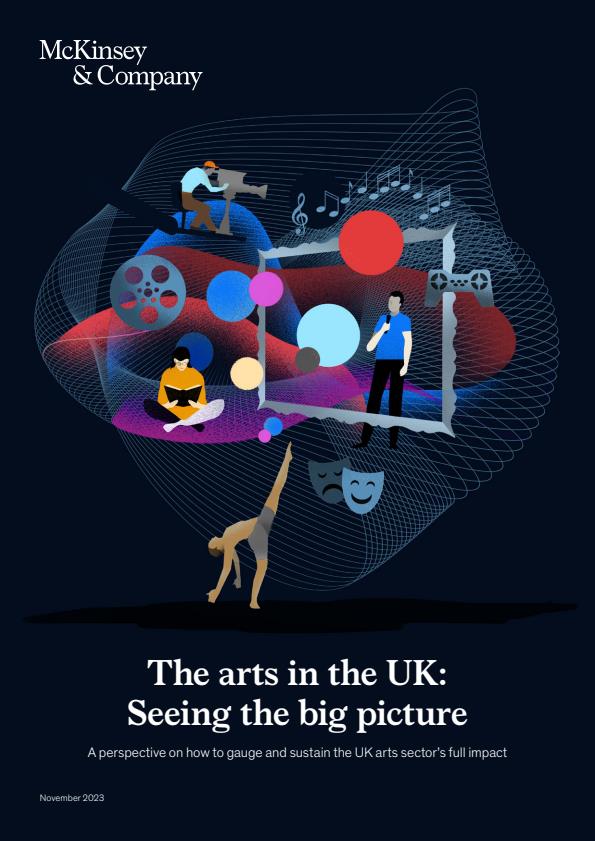The UK arts sector is a dynamic ecosystem of individuals and organisations renowned globally for the quality, diversity, and innovation of their work. Engaging with the arts has intrinsic aesthetic value: it entertains, stimulates the senses, and triggers a wide range of emotional responses. But it has a broader impact too. The ecosystem contributes to the strength of the UK economy by supporting thousands of enterprises and hundreds of thousands of workers. It has a positive effect on the lives of individuals, improving their skills, wellbeing, and health. And it improves the fabric of UK communities—for example, by bringing people closer together.
This broader impact depends not only upon the efforts of the people and organisations involved but also on the health of the ecosystem that includes them. This in turn depends on the strength of the connections within the ecosystem—between different art forms; between for-profit and not-for-profit organisations; between arts organisations in different locations; between local arts organisations, local public bodies, and local businesses; and between the arts sector and the broader creative industries.
A healthy ecosystem sets in train a virtuous cycle: more high-quality artistic activity inspires more engagement, which further increases the impact of the arts. But neglect the ecosystem’s health, and the effects can be just as powerful. The loss of an arts venue in a local community, for example, could prevent its next generation of creative leaders from emerging and weaken its social fabric. Small stimuli can have a far-reaching impact on the ecosystem.
These realities have implications for the art sector’s future. Decisions and actions must recognise how it functions as an ecosystem—taking care not to weaken the connections essential for its health but looking instead for ways to strengthen them. There are opportunities to achieve precisely this.
First, there is an opportunity to better measure and communicate the sector’s impact. Many not-for-profits already demonstrate their impact as part of funding applications. But new, data-driven methodologies capable of measuring impact across a full range of measures could be a powerful strategic tool for all arts organisations. Such methodologies could help to inform planning decisions and organisational priorities, to identify new partnership opportunities and potential donors, and to engage with a broader range of audiences and communities. Earlier this year, McKinsey research, in partnership with seven leading US arts institutions, explored the challenges and opportunities of pursuing such a data-driven approach to measure the impact of arts organisations.1 The DCMS’s ongoing Culture and Heritage Capital Programme, launched in 2021, uses one such approach. It aims to create publicly available statistics and guidance that will permit a more accurate articulation of the value of services provided by culture and heritage.2
Organisations with strong methodologies and metrics could share them with others, helping these to measure and articulate their impact too. Adopting a common, consistent metric would have even wider benefits: each organisation’s measurements could be brought together to form a single coherent view of the ecosystem’s impact—perhaps in a particular art form, in a certain region, or in relation to a certain impact measure.
Second, artists and arts organisations have an opportunity to explore how they might work together in new ways to harness the potential of rapidly evolving technologies. Artists already use AI to enhance the creative process and create entirely new art. Arts organisations already use digital technology to promote greater engagement with the arts, especially by younger audiences—through immersive storytelling, digital education resources, and online streaming, for example.
Artists and organisations in both the arts sector and the broader creative industries, as well as the technology sector, may have opportunities to enhance innovation through even greater collaboration. Arts organisations could, for example, collaborate to develop cutting-edge digital tools to catalogue the collections of museums around the world and to help people engage with them virtually. Or they might explore ways to establish a common framework for using blockchain technology to protect intellectual property or to develop techniques for creating highly personalised user experiences. In all these examples, the sharing of resources—and costs—could speed a project’s development. Arts educators too would have an important role to play by working with innovators to inspire their students and to equip them with the tools they need to begin innovating themselves.
Third, arts organisations could work together to scale up their impact on society. Several of them in a community or region might join forces to achieve a bold ambition—perhaps improving the wellbeing of a meaningful number of residents over five years or contributing to the creation of a more prosperous and attractive community. The pioneers of successful programmes could share their knowledge with other organisations and perhaps form pan-regional groups.
With greater scale, arts organisations would be in a better position to realise their ambitions by drawing in partners and support from beyond the arts—technology companies or organisations in the health or the social-care sectors, for example. New funders that typically would not support an individual arts organisation might be inspired to invest in efforts to pursue a bold societal ambition through the arts. They might even consider making longer-term funding commitments. Local public bodies and businesses in a region or community might sign up, too—some, perhaps, contributing their expertise to help arts organisations develop new capabilities in areas such as impact measurement, technology, or real estate and infrastructure management. Many do so already.
This report has explained the achievements of the UK arts sector, how those achievements are sustained, and how they could reach still greater heights. The result could be more high-quality art in all its forms. Let’s not forget how that can contribute to strengthening the economy, improving the health and education of individuals, and creating more cohesive communities. The arts have the power to affect both lives and livelihoods.
